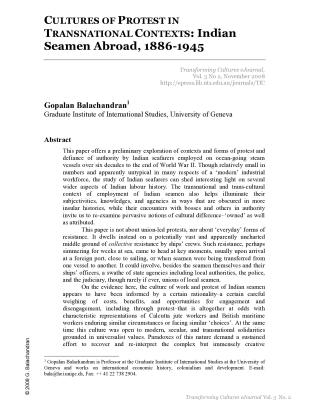This paper offers a preliminary exploration of contexts and forms of protest and defiance of authority by Indian seafarers employed on ocean-going steam vessels over six decades to the end of World War II. Though relatively small in numbers and apparently untypical in many respects of a ‘modern’ industrial workforce, the study of Indian seafarers can shed interesting light on several wider aspects of Indian labour history. The transnational and trans-cultural context of employment of Indian seamen also helps illuminate their subjectivities, knowledges, and agencies in ways that are obscured in more insular histories, while their encounters with bosses and others in authority invite us to re-examine pervasive notions of cultural difference–‘owned’ as well as attributed. This paper is not about union-led protests, nor about ‘everyday’ forms of resistance. It dwells instead on a potentially vast and apparently uncharted middle ground of collective resistance by ships’ crews. Such resistance, perhaps simmering for weeks at sea, came to head at key moments, usually upon arrival at a foreign port, close to sailing, or when seamen were being transferred from one vessel to another. It could involve, besides the seamen themselves and their ships’ officers, a swathe of state agencies including local authorities, the police, and the judiciary, though rarely if ever, unions of local seamen. On the evidence here, the culture of work and protest of Indian seamen appears to have been informed by a certain rationality–a certain careful weighing of costs, benefits, and opportunities for engagement and disengagement, including through protest–that is altogether at odds with characteristic representations of Calcutta jute workers and British maritime workers enduring similar circumstances or facing similar ‘choices’. At the same time this culture was open to modern, secular, and transnational solidarities grounded in universalist values. Paradoxes of this nature demand a sustained effort to recover and re-interpret the complex but immensely creative subjectivities that Indian workers and seafarers (and needless to add other Asian, African, and Caribbean workers and seamen) developed and articulated within the fluid and liminal spaces they inhabited.



